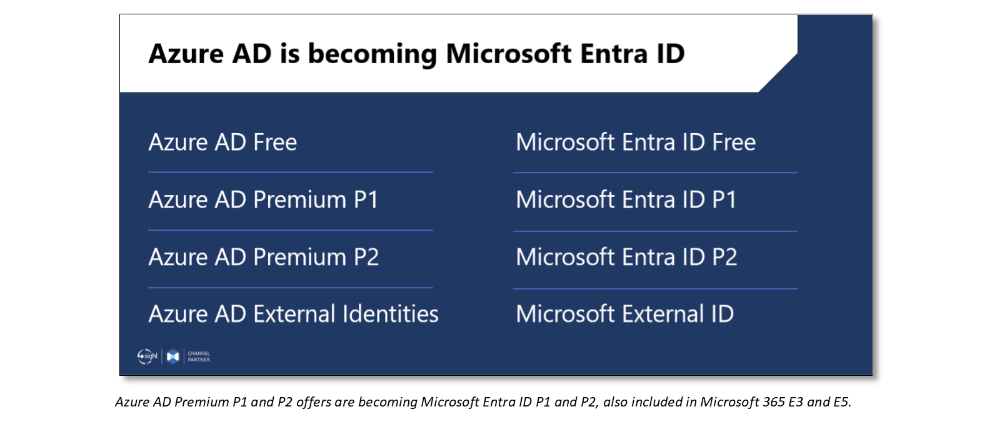Blog - Channel Partner
Microsoft Entra ID: Pioneering the Future of Identity Management

Today, we delve into the evolution of identity management, tracing the origins of Azure Active Directory and its pivotal role in shaping secure access to cloud-based services and exploring the motivations behind the creation of Microsoft Entra ID. Keeping in mind that Microsoft Entra, which was introduced to us more than a year ago by Microsoft. Now, a flavour of Entra is aimed as a revolutionary successor to Azure AD.
Let’s examine its cutting-edge features, decentralized identity approach, and blockchain integration.
In the ever-evolving landscape of technology, the need for robust and secure identity management solutions has never been more crucial. Microsoft has long been a frontrunner in addressing this challenge, and its Azure Active Directory (Azure AD) has played a central role in providing seamless authentication and access control for cloud-based services. However, to meet the demands of an increasingly digital and decentralized world, Microsoft has introduced the next-gen identity management platform, Microsoft Entra ID. In this blog, we'll traverse the history of Azure AD, discover its purpose and significance, and explore the innovations brought forth by Microsoft Entra ID.
Let’s keep in mind that only the name is changing as no action is required from administrators as it’s a seamless transition and you can continue to rely on the familiar Azure AD capabilities access through the Azure portal, Microsoft 365 admin center, and the Microsoft Entra admin center.
The Journey of Azure Active Directory
Azure Active Directory made its debut in 2012 as a cloud-based identity and access management solution. The rapid proliferation of cloud services had rendered traditional on-premises identity management solutions inadequate for the modern digital ecosystem. Microsoft identified the necessity for a scalable, flexible, and secure platform to manage user identities, facilitate single sign-on (SSO), and implement robust security measures across cloud-based applications.
The Purpose and Significance of Azure Active Directory
Azure Active Directory serves several critical purposes, making it an integral part of modern business operations:
- Centralized Identity Management: Azure AD allows organizations to manage user identities centrally, simplifying user provisioning, deprovisioning, and access control across various applications and services.
- Single Sign-On (SSO): Users can access multiple applications and resources using a single set of credentials, reducing the burden of remembering multiple passwords and enhancing productivity.
- Security and Compliance: Azure AD offers advanced security features, including multi-factor authentication (MFA) and conditional access policies, to protect against unauthorized access and data breaches.
- Integration with Microsoft Services: Azure AD seamlessly integrates with Microsoft 365, Azure services, and thousands of third-party applications, creating a unified ecosystem for identity and access management.
Introducing Microsoft Entra ID
As technology advanced and new challenges emerged, Microsoft recognized the need to redefine identity management for the future. Microsoft Entra ID is a revolutionary identity platform built on the foundations of Azure AD, offering enhanced security, user-centricity, and decentralized identity management.
 Features of Microsoft Entra ID
Features of Microsoft Entra ID
Microsoft Entra ID introduces a range of cutting-edge features that set it apart from its predecessors:
- Decentralized Identity Management: Entra ID leverages decentralized identity technologies, allowing users to retain greater control over their digital identities and personal data while ensuring enhanced security and privacy.
- Self-Sovereign Identity (SSI): Users can autonomously create and manage their digital identities, reducing reliance on central authorities and putting individuals in charge of their identity data.
- Interoperability: Entra ID is designed to be interoperable with existing identity systems and protocols, enabling a seamless migration path for businesses already using Azure AD.
- Blockchain Integration: By utilizing blockchain technology, Entra ID ensures the immutability and integrity of identity data, minimizing the risk of data breaches and identity fraud.
- Enhanced Privacy: Entra ID incorporates advanced privacy features, enabling users to share only the necessary identity attributes with service providers, reducing unnecessary data exposure.
The reason’s why Microsoft is changing Azure AD to Microsoft Entra ID
At the time, the Microsoft Entra product family included Azure AD plus two new products, being Microsoft Entra Permissions Management, a cloud infrastructure entitlement management product, and Microsoft Entra Verified ID, a decentralized identity solution.
Since then, Microsoft added several new products into the Microsoft Entra family, being Microsoft Entra ID Governance, Microsoft Entra Workload ID, and the new products we introduced today, Microsoft Entra Internet Access and Microsoft Entra Private Access. All to advance Microsoft’s promise to deliver a complete repertoire of solutions that provide secure access for any identity to any resource.
Customers have embraced the new Microsoft Entra products while continuing to rely on Microsoft’s hero cloud identity product, Azure AD, that currently protects over 720,000 organizations worldwide. Microsoft sees that most customers successfully deploy Microsoft’s new products alongside Azure AD, bringing to life Microsoft’s vision for unified secure access with Microsoft Entra.
Unifying all identity and access capabilities under the Microsoft Entra name will make it easier to navigate and use all products and capabilities in our expanded portfolio, ensuring that you have the strongest protections for any access point. Microsoft is also standardizing the use of the term “ID” for all our identity products: Microsoft Entra ID, ID Protection, ID Governance, External ID, Workload ID and Verified ID.
Please contact our Surestep Ambassador team to book a session to get more information.


